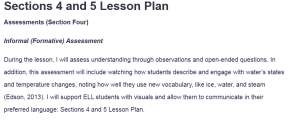Sections 4 and 5 Lesson Plan
Assessments (Section Four)
Informal (Formative) Assessment
During the lesson, I will assess understanding through observations and open-ended questions. In addition, this assessment will include watching how students describe and engage with water’s states and temperature changes, noting how well they use new vocabulary, like ice, water, and steam (Edson, 2013). I will support ELL students with visuals and allow them to communicate in their preferred language: Sections 4 and 5 Lesson Plan.
Formal (Summative) Assessment
For a summative assessment, I will plan a “Water Museum” where students can share their new knowledge using drawings, models, or short presentations. This activity allows students to express understanding in various ways, such as describing water’s transformations in a picture book or verbally explaining melting and evaporation. I will encourage a “water journal” for documenting changes they observe outside the classroom, reinforcing concepts in familiar contexts.
Facilitating Student Engagement & Learning (Section Five)
Timeline of Activities
- Demo with ice, water, and steam.
- Discuss key terms and activity setup.
- Hands-on centers (ice, water, steam).
- Use thermometers; discuss observations.
- Group discussion on findings.
- Summarize and dismiss by review questions.
Beginning: I will introduce the lesson by gathering students and sparking curiosity with ice, water, and a cup with steam. I will ask them to share what they know about these materials, guiding them toward key vocabulary like melt, freeze, and evaporate. I will set the stage by explaining that they will explore these changes in small groups.
Middle: At exploration centers, students will handle ice, observe water, and watch steam form, discussing their observations in small groups. Digital thermometers will help them connect temperature with state changes. I will guide them with questions like, “What happens to the ice over time?”
End: I will bring students back together to discuss what they discovered at each center. I will encourage them to use key terms as they share. Next, I will summarize the lesson by reinforcing the relationship between temperature and water’s states. Finally, I will dismiss them in small groups based on answers to review questions, providing a final recap and classroom transition.
References
Edson, M. T. (2013). Starting with science: Strategies for introducing young children to inquiry. Stenhouse Publishers.
ORDER A PLAGIARISM-FREE PAPER HERE
We’ll write everything from scratch
Question 
OKAY, SO THIS IS SECTION 4 & 5 OF MY LESSON PLAN. I UPLOADED SECTIONS 1, 2 & 3 FOR YOU TO LOOK AT BEFORE DOING SECTION 4 & 5. YOU GUYS ARE REVISING SECTIONS 2 & 3 I UPLOADED THE ONE WITH MY PROFESSORS FEEDBACK SO YOU CAN VIEW IT UNTIL THE REVISED IS DONE. I UPLOADED THE INSTRUCTIONS FOR SECTIONS 4 & 5 TO THIS ORDER BE SURE TO REVIEW IT BEFORE WORKING ON THIS AS WELL.
Assessments (section four)
What is your plan for assessing the outcome of this specific lesson’s goal/objective?
- Informal (Formative)
- Formal (Summative)
___________________________________________________________________________

Sections 4 and 5 Lesson Plan
Facilitating Student Engagement & Learning (section five)
Timeline of Activities: Please list them in order – you may bullet this section.
Beginning: How will you introduce the lesson:
Middle: What will the children be doing during the main part of the lesson:
End: How will you wrap up the lesson and conclude:
